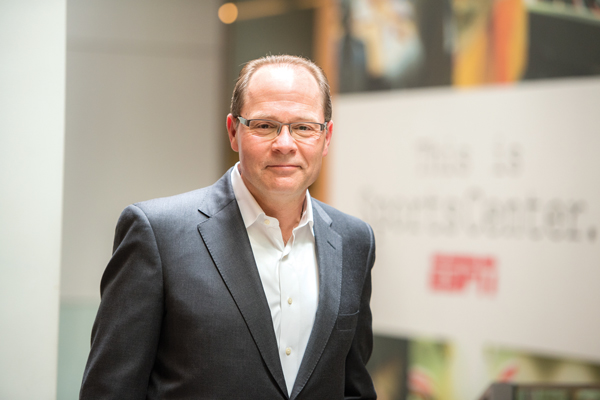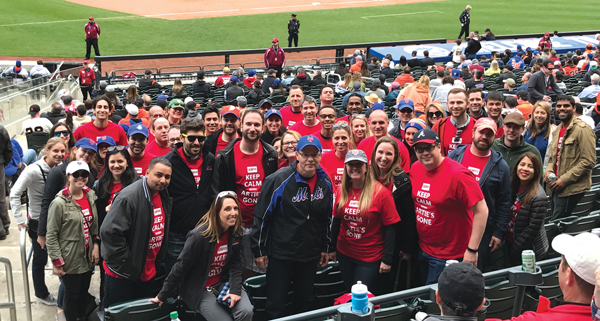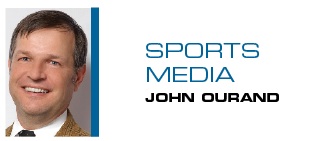Best known in the sports business as a bookish, analytical media researcher,
Artie Bulgrin cuts somewhat of a different persona inside ESPN’s offices. ESPNers are more apt to describe Bulgrin as a Mets fan, a guitarist for a classic rock band and an all-around good guy than as the dean of sports media researchers, which he has become over the past two decades.
Take Norby Williamson, for example. When asked how he would describe Bulgrin, ESPN’s executive vice president of studio and event production told a decade-old story of Bulgrin as a Mets fan.
It was 2007, and Williamson and Bulgrin were at Shea Stadium, where the Mets had to win the last game of the season against the 91-loss Marlins to advance to the playoffs. Ace pitcher Tom Glavine was on the mound, but he flopped and gave up seven first-inning runs. The Mets lost. The previous season, Williamson and Bulgrin also were at Shea to see Mets outfielder Carlos Beltran strike out looking with two outs and the bases loaded in the bottom of the ninth as the Mets lost Game 7 of the NLCS to the Cardinals.
“That was the lowest of the low for Mets fans,” said Williamson, who also supports the Mets. “But no matter how much despair there is, Artie remains calm, analytical, calculating. Things will always be OK with him. That drives me a little nutty. At some point I want to see him get totally pissed off and break something as we root for this team. But he’s not, and that’s part of his charm and it’s part of who he is.”
 |
Artie Bulgrin, who built research and analytics at ESPN, will retire at the end of this month.
Photo by: ESPN IMAGES
|
That description also rings true for Sean Bratches, Formula One’s managing director of commercial operations who previously was Bulgrin’s boss at ESPN.
“Artie is always the calm in the eye of the storm,” Bratches said.
The bespectacled Bulgrin, 58, will retire at the end of this month, take the summer off and look into picking up advising and consulting work with media companies, like, he hopes, ESPN. During Bulgrin’s 21-year ESPN career, he earned a sterling reputation as one of the most trusted researchers in the business. Friends and colleagues are quick to describe him as smart and analytical, but they also focus on other aspects of Bulgrin’s personality that have made the unassuming research executive one of the best-liked people at ESPN.
When news of his pending retirement leaked in February, ESPNers from all levels reacted with a sense of disbelief that someone so integral to ESPN would be leaving. It resulted in a three-month-long goodbye, one that saw Bulgrin surprise his colleagues by shaving off his trademark mustache.
Loyalty to Bulgrin is all around. Last Wednesday, Bulgrin’s staff skipped work and took their boss to a Mets game against the Giants. Anyone who sent an email to ESPN’s vice president of media intelligence, Dave Coletti, received the following out-of-office message: “In honor of Artie Bulgrin’s retirement I am taking Artie out to the ballgame today, along with the entire ESPN Fan & Media Intelligence team. If you have an urgent request we will get back to you after the last out. Let’s Go Mets!”
“Artie is a true titan of the industry who for two decades has been a sage and calming voice amid a sea of change,” said ESPN President John Skipper. “I know I am not alone in saying that he will be missed — not only for his counsel, but for his friendship — and for being an integral part of the fabric of ESPN.”
Bulgrin’s ESPN career started in 1996, when former ESPN President George Bodenheimer hired him away from ABC to be one of ESPN’s two researchers. Bodenheimer wanted Bulgrin to build up the research department, which he did. Today, ESPN’s research and analytics group run by Bulgrin has about 60 people spread across several continents.
Bodenheimer delivered a simple message to Bulgrin when he hired him. He wanted Bulgrin to ingratiate himself with advertisers, cable operators and the press. That public persona helped Bulgrin become the dean of sports media researchers — someone who has earned respect from competing networks.
For example, when reporters call research executives at rival networks, many times the executives start the conversation by asking, “What did Artie say?”
“George gave me the freedom to do that,” Bulgrin said.
 |
Bulgrin’s staff took the researcher to see his beloved Mets last week, sporting shirts saying “Keep Calm When Artie’s Gone.”
Photo by: ESPN IMAGES
|
Bulgrin recalled a presentation he gave at an off-site meeting at the Tarrytown, N.Y., Hilton six months into his ESPN job. He detailed how ESPN was doing and the presentation went well; Bulgrin was feeling good. As he was packing up to leave, though, Bodenheimer called him and said, “I forgot I put you on the agenda for the ESPN board meeting this afternoon in New York at ABC.”
“I wasn’t prepared. I wasn’t dressed for it,” Bulgrin said. “I bought a tie at the hotel store and raced down in my car to our office on 66th Street. It was intimidating. The board had luminaries like Roone Arledge and Steve Burke. But it went fine, and ever since then, George would recommend me to speak at different conferences. Then I learned to become very active in the research community. I found it valuable because it gave us the outlet to tell our story to the industry — whether it was with the Advertising Research Foundation or the Cable Advertising Bureau or the Media Ratings Council.”
Bulgrin is called “Artie” by everyone inside ESPN except Bodenheimer, who calls him “Arthur,” and Bratches, who has been known to call him “Red Hot Artie.”
Bratches laughed as he told the story of the “Red Hot Artie” nickname, which came during an off-site sales meeting a couple of years ago. ESPN had brought in actors as a way to lighten the mood during the meeting.
“One actress really took a liking to Artie,” Bratches said. “Over the three days, she would always come into the room and shout out, ‘Where’s Red Hot Artie?’”
■ ■ ■ ■
ESPNers love to tell stories of Bulgrin’s personality because his work as ESPN’s top researcher is so respected.
Bulgrin has had as much impact on ESPN’s business over the past two decades as many of the network’s better-known executives. It’s hard to find a part of ESPN that did not rely on Bulgrin. He influenced decisions that affect programming, ad sales and affiliate relations.
Take the decision 16 years ago to program the late afternoon with original studio shows, like “Pardon the Interruption.” That’s the example that Williamson uses when he talks about Bulgrin’s ESPN influence.
“He was sort of like a mad scientist that made us look at our networks in a totally different way,” Williamson said. “We always thought of 5:30 p.m., where ‘PTI’ currently resides, as a wasteland. He looked at the numbers and convinced us that we could attack that area.
“Prior to that, we put all sorts of garbage on in the afternoon, goofy things like ‘Racehorse Digest.’ Artie really opened our eyes to the fandom that wasn’t being served at that time. He brought us into that culture and availability of audience that really catapulted a lot of our growth.”
Bulgrin also was a regular on ad sales calls, said Ed Erhardt, ESPN’s president of global sales and marketing. Bulgrin would be deferential and quiet during the pitch, eventually coming alive as he presented his findings.
“It was magical when he became animated about something that he cared so much about,” Erhardt said. “That authenticity always resonated. We didn’t have to do a lot of selling after he got done talking.
“The ability to tell a story around the numbers is always one of the great things that great researchers can do. Artie could definitely do that kind of thing when he was in the mode of sharing with our customers how sports fans were doing whatever they were doing at that particular time.”
During his ESPN career, Bulgrin was instrumental in developing a cross-platform measurement that’s being used across the industry. He helped develop the ESPN Sports Poll, and started the “ESPN All Day, Every Day” measurement to quantify ESPN’s total audience.
He oversaw the launch of the ESPN Ad Lab eight years ago and has been ESPN’s point person in pushing Nielsen to measure out-of-home viewing.
Bulgrin is proud of the team he has assembled, and it’s certain that his departure will be felt by ESPN.
“Artie is unequivocally the thought leader in the industry that led the business into cross platform measurement and permitted media companies around the globe to release value in the new media world,” Bratches said. “The value he created in this regard resonates across the landscape today.”
John Ourand can be reached at jourand@sportsbusinessjournal.com. Follow him on Twitter @Ourand_SBJ.






